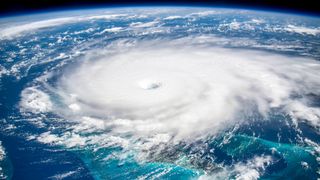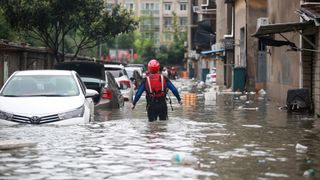
Is climate change making the weather worse?
Dinosaurs might have experienced worse weather, but they didn't cause it.

United Nations climate scientists say it's "now or never" to stop catastrophic temperature rises and a breakdown of the climate systems on which our way of life depends. Reports of bomb-like blizzards and searing droughts paint a terrifying picture of the possible reality of climate change. But are we actually witnessing the weather getting worse?
Unfortunately, the answer is yes. Weather is getting worse for people in the U.S. and globally, Spencer Weart, a historian and retired director of the Center for History of Physics at the American Institute of Physics in College Park, Maryland, told Live Science.
Climate is the average of weather over time, and Earth has a long and dramatic history of natural climate change. The Triassic period (252 million to 201 million years ago) may have ended with a million-year rainstorm. And the dino-killing asteroid hitting Earth at the end of the Cretaceous period (145 million to 66 million years ago) plunged parts of the sky into cold darkness for years under dense clouds of ash and particles; then, Earth's temperatures spiked for 100,000 years, due to the colossal amount of carbon dioxide the asteroid kicked up when it smashed into the Yucatán Peninsula; a massive asteroid strike is still technically a natural event, albeit a sad one for the dinosaurs.
While major climatic swings are nothing new to our planet, they have been incredibly destructive in the past, and our current insatiable appetite for fossil fuels is setting in motion a rapid swing that could have dire consequences for humanity.
Related: Has the Earth ever been this hot before?
Modern records reveal an unnatural global warming trend taking hold of Earth's climate in recent decades. By burning fossil fuels, humans are sending heat-trapping carbon dioxide and other greenhouse gases into the atmosphere that are raising global temperatures.
Experimental data and climate models suggest this warming will affect weather in a variety of ways, making it hotter and colder, more extreme, more chaotic and in a word, "worse." For example, as the world gets warmer, more water evaporates from the surface of dry areas and increases precipitation in wet areas, according to Weart. In other words, dry areas get drier and wet areas get wetter. More moisture in the atmosphere in a warming planet can also lead to heavier snowfall during the winter.
Sign up for the Live Science daily newsletter now
Get the world’s most fascinating discoveries delivered straight to your inbox.
Weart pointed to severe North Atlantic hurricanes in the Caribbean and U.S. in recent years, as well as hurricanes, or tropical cyclones, around the world as examples of worsening weather. "There's very little question that everywhere the hurricanes are getting worse," he said.
We are not necessarily seeing an increase in the number of hurricanes, but the bad ones are becoming more severe. "What would have been a Category 3 [hurricane] is a Category 4, what would have been a Category 4 is a Category 5," Weart said.
Category 5 includes the strongest hurricanes, with winds of 156 mph (251 km/h) or more. There's no Category 6 hurricane because the Saffir-Simpson scale only deals with wind, and the damage wind does is about the same above 156 mph, although some scientists think the scale needs revising, Live Science previously reported.

Meanwhile, record-breaking weather events, such as the 2018 heatwave in Japan that killed more than 1,000 people, are likely to become more common, Weart noted. For instance, in a 2018 study published in the journal Scientific Online Letters on the Atmosphere (SOLA), researchers ran climate computer simulations and found the heatwave could not have happened without human-induced global warming. A 2020 study published in the journal Nature Communications also found heatwaves are increasing around the world.
Furthermore, although it sounds counterintuitive, global warming could be causing colder snaps. A 2021 study published in the journal Science found a warming Arctic and disruptions to the swirling cold winds above it called the polar vortex is linked to more extreme winters in the Northern Hemisphere, including the U.S., but climate scientists are still debating this link, Nature reported.
Climate change may have the potential to disrupt the weather systems so much that Earth turns into a chaotic world that can't be fixed, Live Science previously reported. A 2022 study published on the preprint database arXiv found that if we don't reduce our emissions, humans run the risk of Earth's temperature fluctuating chaotically in a way that's impossible to predict.
So, what are we doing to combat climate change and stave off a future filled with more terrible weather? Nations around the world signed up to the Paris Climate Agreement in 2015 and agreed to keep warming preferably below 2.7 degrees Fahrenheit (1.5 degrees Celsius) and well below 3.6 F (2 C). But, in 2022, the UN Secretary-General António Guterres said at the Economist Sustainability Summit that the 1.5-degree goal was on "life support" and with continued emissions, "we are sleepwalking to climate catastrophe."
World leaders need to ensure that global carbon dioxide emissions begin declining by 2025 and are halved by 2030 if we are to stay within 1.5 C of warming, according to the latest Intergovernmental Panel on Climate Change (IPCC) report — likely the last IPCC report before irreversible climate breakdown becomes unavoidable, Live Science previously reported.
"It's like we've suddenly become a protagonist in a science fiction movie: 'only you can save civilization from global disaster,'" Weart said. "But it's not science fiction."
Originally published on Live Science.

Patrick Pester is a freelance writer and previously a staff writer at Live Science. His background is in wildlife conservation and he has worked with endangered species around the world. Patrick holds a master's degree in international journalism from Cardiff University in the U.K.
